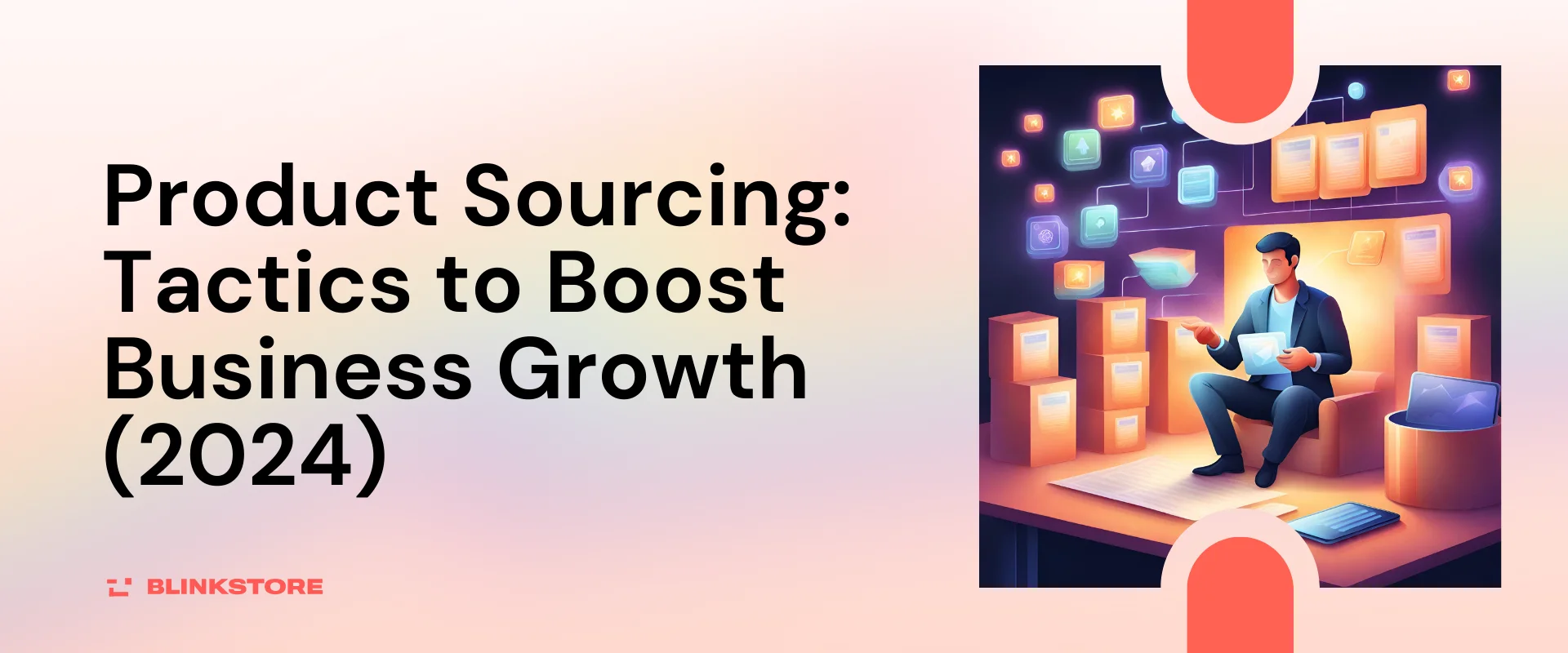With product sourcing, you obtain authority over item costs, quality of products earned from profits or margins, and handling consumer needs. Lack of strategic sourcing can lead companies to dead stock, out-of-stock items, overstocks, and all inventory problems that cut off sales.
This article will provide an extensive overview of product sourcing fundamentals for new ecommerce merchants and retailers. Key topics include:
- Defining product sourcing and its core concepts
- Evaluating the main sources for sourcing merchandise, both domestically and overseas
- Factors to consider when vetting and selecting supplier partners
- Best practices for sourcing branded and wholesale products
- Key considerations around quality, costs, minimum order quantities, reliability, and more
- Building relationships with manufacturers and suppliers for the long-term
Table of Contents
Introduction
Product sourcing refers to the act of spotting products that can be sold as line items in retail stores or on websites. In both e-commerce businesses and retailing, choosing the right sources for merchandise is a decisive factor as a successful acquisition point will lead to better efficiency.
The right choice in sourcing strategies can help companies find the best type of inventory that meets their target customers. To this end, retailers and e-commerce stores can rely on the arguments articulated in this article to make informed decisions for sourcing that help them get the greatest possible chances of improved growth and profitability. The essence of upbringing is adopting a consistent and methodical attitude.
What is product sourcing?

Product sourcing refers basically to the acquisition of products from overseas sources for resale through retail channels. The scope of purchasing activities includes identifying crafting, selecting, engaging in negotiations with manufacturers as well as wholesale suppliers, and building relationships with such partners.
For any retail business, from large big-box retailers to small ecommerce shops, careful product sourcing is essential. It provides companies access to the raw materials and finished products that make up their catalog and inventory. Strategic sourcing is crucial because it impacts:
- Cost of goods sold (COGS) – Finding the best product rates allows for maximized profit margins
- Product quality – Vetting suppliers helps ensure merchandise meets standards
- Inventory management – Building relationships with reliable vendors avoids stockouts
- Variety and customization – Sourcing gives access to wide range of products
Fundamentally, product sourcing provides businesses control over their supply chain. Retailers that excel at sourcing can offer competitive pricing to undercut rivals. They can provide unique or hard-to-find items that attract customers. They can also achieve high fill rates and inventory turns with the right sources. It alleviates reliance on just one supplier.
For online sellers, product sourcing is necessary to discover trending and in-demand merchandise. For brick-and-mortar store owners, it determines budgeting for store layouts and merchandise planning. Across verticals, efficient sourcing is the catalyst driving profits. It combines data-driven and operational expertise for optimal inventory planning and management
Read more about: How to Sell Products Online (2024): The Complete Guide for Beginners
Sources of Products for Businesses
1. Domestic Manufacturing

Sourcing products domestically from local manufacturers can provide retailers quicker turnaround times, lower shipping costs, and easier coordination. Working with manufacturing partners within the same country removes logistical hurdles and barriers when importing goods.
Key advantages include:
- Faster shipping/delivery
- Lower minimum order quantities
- Shared language/culture for easier communication
- Ability to visit and audit facilities regularly
- Reduced compliance concerns and import taxes
Limitations center around higher production costs due to local labor rates, real estate, etc. This gets passed through as higher wholesale costs. The range of products may also be limited.
2. Overseas/Foreign Manufacturing

To significantly reduce the cost of goods sold (COGS), many retailers look to overseas importing from low-cost manufacturing countries. This leverages cheaper raw materials, components, and labor pools abroad.
Popular product sourcing destinations include:
China – For high volume production of electronics, toys, textiles, plastic goods at low price points. Labor intensive products can be produced cheaply, however product safety regulations are still maturing.
India – Major exporter of textiles, fabrics, fibers, apparel and handcrafted goods. Specializes in natural materials like wool, silk, cotton, leather . Customization possible.
Vietnam/Indonesia – Growing manufacturing centers focused currently on apparel, footwear, and simple mechanical items. Infrastructure and output capacity increasing to rival China.
Bangladesh – Dominates the apparel sector due to ultra-low labor wages. Higher risk of compliance issues around safety and labor rights. Production capacity improving over time.
Product sourcing overseas has led to the concepts of global supply chains and global trade. It allows major retailers to sell affordable merchandise by reducing manufacturing costs. However, businesses must weigh benefits vs. the risks around quality control, shipping times, customs procedures, and cultural barriers.
3. Wholesale Suppliers

A third product sourcing option is domestic or overseas wholesale vendors specializing in distribution. These B2B firms sell in bulk to retailers who then sell smaller quantities to individual consumers. Many will handle logistics like storage and delivery.
Sourcing from wholesale suppliers reduces hassles interfacing directly with factories. It provides access to inventory that can be resold immediately without large upfront product orders. However, margins can be lower as the wholesaler adds their own markup.
4. Dropshipping

Dropshipping has grown tremendously with the rise of ecommerce sellers operating online stores. With dropshipping, retailers can list products from a supplier’s catalog without actually holding any inventory. When a customer places an order, the sale triggers a purchase order and shipment directly from the supplier’s warehouse to the customer’s doorstep.
This just-in-time arrangement offloads overhead costs around warehousing, logistics and working capital for the retailer. Product sourcing is also simplified – ecommerce sellers can find thousands of dropship merchandise options and list them through plugins on online marketplaces.
The main downside is low margin per sale, as the intermediaries take their cut. Still, dropshipping has enabled countless micro e-commerce businesses to launch without major upfront investment. As they grow, more cost-efficient sourcing options can be introduced.
Read more about: How to Start Dropshipping for Free in 2024 – Complete Guide
Key Factors to Consider When Sourcing Products
There are several critical aspects for retailers to evaluate when sourcing and selecting suppliers for their product inventory. Each decision carries major implications for the profitability and operations of a retail business.
1. Cost
The cost to purchase goods from a manufacturer or vendor determines the potential profit margin. Lower production costs allow retailers to maximize margins while remaining price competitive in the market. Key drivers of cost include:
- Unit cost per item
- Order volumes/Minimum Order Quantities (MOQs) that trigger price breaks
- Customization services or product modification fees
- Cost of shipping and freight to transfer goods
With overseas sourcing, additional costs may include import duties, taxes, and compliance testing if required. Retailers must assess total landed cost to determine true order pricing.
2. Quality
Product defects lead to dissatisfied customers, returns and refunds. Retailers must implement quality assurance steps to verify sourced merchandise meets safety guidelines and expected durability standards before accepting shipments.
Common quality checks include:
- Materials inspections – verifying correct textiles, weights, etc
- Testing assembly and workmanship
- Review of certifications from vendors
- On-site visits and audits
For overseas suppliers, third party inspection agencies can provide boots on the ground assessments if retailers cannot perform checks personally.
3. Reliability & Trust
Will suppliers deliver orders on schedule as promised? Retailers suffer when facing unreliable vendors or shortage delays, as it quickly leads to stockouts. Factors determining reliability:
- Production capacity – can they handle large orders or surges?
- Business longevity and track record with other clients
- Quality and retention of employees/workers
- Contingency planning for emergencies or back-ups
Closely tied to reliability is the element of trust in the working relationship between retailer and supplier. Trust ensures transparency around issues as they arise for quick resolution.
4. Minimum Order Quantities (MOQs)
Suppliers will each set order requirements to begin production. Retailers with lower sales volumes may struggle to meet MOQs for the most cost-efficient manufacturers. On the other hand, purchasing too much inventory ties up capital and raises carrying costs. Understanding minimums and negotiating accordingly is key.
5. Shipping Times & Costs
Finalizing production schedules aligns with transportation lead times to ensure goods arrive on retail shelves to meet customer demand. Global supply chains must account for ocean freight transit if sourcing overseas. Retailers can opt for faster air freight at higher expense if necessary.
6. Customization Abilities
Seeking custom merchandise or white label goods requires finding suppliers with flexible capabilities around specifications, labeling, packaging and more. The associated setup costs must align with budget. Retailers with large volumes can leverage custom orders to enhance differentiation from competitors.
Carefully examining each of these elements creates transparency around suppliers’ offerings and limitations. The tradeoffs must suit the retailer’s specific business model, go-to-market strategy and budget. Product sourcing is a commitment which lays the foundation for the customer experience.
How to Source Branded and Wholesale Products
Retailers looking to resell popular branded merchandise, or source a range of products to sell wholesale, have several effective channels:
1. Trade Shows

Industry trade shows provide direct access to an aggregated set of manufacturers, brands and suppliers under one roof. Across verticals like consumer electronics, home goods, apparel, food & beverage, gift items and more, trade shows enable relationship building, product discoveries & cost negotiations.
Retailers can meet with company sales reps, explore new product launches hands-on, secure samples on upcoming inventory, and make large wholesale commitments through show specials and discounts. These events connect major players across the global supply chain.
2. Online B2B Platforms

For year-round buying and discovery, a number of large B2B ecommerce marketplaces have emerged. These digital platforms showcase a diverse, multi-category range of branded goods for wholesale purchase and distribution to retailers. Companies can directly connect with suppliers through the portal to place orders and arrange logistics.
Popular examples include Alibaba.com, Globalsources.com, Made-In-China.com, Dhgate.com and IndiaMart.com. Retailers can search thousands of products, evaluate company profiles, and message contacts. This opens up a network of suppliers from overseas markets ready to engage new distribution partners in the West.
3. Overseas Buying Agents

Retailers can overcome barriers around language, business culture and geographic distance when importing goods by leveraging overseas buying agents. These locally-based supply chain specialists provide boots-on-the-ground supplier vetting and coordination when navigating foreign manufacturing hubs.
Buying agents typically have existing relationships with factories, can assist with sourcing custom designs, manage logistics, ensure order quality and resolve issues through local connections – providing essential domain expertise. Hiring an agent alleviates headaches so retailers focus on sales and marketing. Their commissions and fees pay dividends through improved overseas supply chain performance.
Best Practices for Product Sourcing
For retail businesses, implementing structured processes for engaging suppliers sustains growth. It leads to mutually beneficial partnerships. Key areas to develop robust frameworks around include:
1. Vetting Suppliers
Before finalizing a manufacturer or vendor, retailers should vet and qualify options across essential criteria:
- Years in business, reputation, client references – This indicates stability and experience.
- Range of products – Catalog size and variety shows production capabilities.
- Quality certifications – ISO compliance reflects standardized operations.
- Previous quality issues – Transparency builds trust.
- Production capacity – Can they handle fluctuations in demand?
- Location and facilities – On-site visits verify claimed assets exist.
- Use of subcontractors – Third parties may increase risks.
Developing a supplier scorecard methodology based on weights assigned to each critical factor ensures impartial, consistent evaluations.
2. Negotiating Costs
Sourcing teams approach negotiations equipped with data points on current market rates based on competitors or industry benchmarks. This allows reasonable counter-offers backed by evidence if suppliers’ initial quotes seem inflated.
Areas open for negotiation include:
- Unit pricing – volume discounts possible?
- Payment terms – prepayment risks vs. benefits of extended terms
- Shipping modes and INCOTERMS – FOB vs DDP, air vs ocean
- Customization fees – simpler adaptations may be free
Win-win outcomes reward top suppliers with higher volumes in exchange for greater wholesale discounts. This incentivizes both sides to collaborate.
3. Quality Inspections
Even reputable suppliers can experience defects in materials or workmanship. Retailers protect customers and margins by implementing acceptance processes:
- Specification checks before shipment leaves facility
- Review certificate of analysis from supplier or third party agency
- Random batch sampling for flaws upon receipt
- Destructive testing on a small percentage of units for durability
Addressing issues early prevents larger problems down the road. It also motivates suppliers to tighten controls, knowing clients verify quality.
4. Building Long-Term Supplier Relationships
Retailers focus on nurturing a limited base of trusted, proven partners over the long run to reduce churn and learning curves with new vendors. Loyalty and higher volumes create incentives for suppliers to offer their best work. Ongoing communication around product roadmaps or peak seasons facilitates planning and commitment. Supply chain visibility through shared data reduces surprises. And investments in supplier operational improvements can lift capabilities over time.
With robust, structured approaches to managing partnerships – from selection through growth – retailers reap the benefits of strategic product sourcing. This lifecycle mindset leads to reliable inventory and maximum profitability.
Conclusion
With manufacturing being the source of life to retail, retailers must source products and fulfill customer’s demands However, identifying and monitoring the best suppliers globally demands knowledge in geometry cycles that incorporate abilities of operation, analytics, and relationship building. For retailers to attract opportunities and choose optimal partners that they can work with, the right balance of cost criteria along with quality and reliability should go hand in hand with aligning their business strategies and constraints.
Many financially stressed suppliers recognize that they cannot run a successful business without ensuring proper use of the four structured sourcing frameworks – vetting vendors, negotiating fair contracts, inspecting shipments, and nurturing long-term partnerships – giving corporations control over their supply chain. This allows the creation of seamless inventory flows to the shelves or e-commerce customers. Active product sourcing implies that through this strategy retailers, both small and big can concentrate on sales by the back end delivers.
FAQs on Product Sourcing
What is product sourcing?
Product sourcing refers to the process of identifying and procuring inventory to sell, either in retail stores or through an ecommerce business. It involves determining optimal suppliers and manufacturers to purchase merchandise from at the right price points and quality to meet sales goals.
What are the main sources for product sourcing?
The main product sourcing sources include domestic manufacturers within a company’s home country, overseas/foreign factories located abroad in low-cost countries like China or India, wholesale suppliers and distributors specializing in B2B sales, and dropshipping arrangements where suppliers ship directly to customers.
Why should companies source products globally?
Global product sourcing allows businesses to significantly reduce manufacturing costs and cost of goods sold. By importing inventory from overseas suppliers in regions with lower labor, materials and real estate, retailers can resell at much cheaper price points with higher profit margins.
What factors to consider when selecting product suppliers?
Key supplier criteria consist of cost, product quality, reliability in meeting order volumes/deadlines, minimum order quantities or MOQs, shipping times, customization abilities, certifications, years in business, and production capacity.
How to source private label and branded items for resale?
Retailers can find branded merchandise and white label products to sell by attending trade shows to meet suppliers firsthand, leveraging online B2B sourcing platforms like Alibaba or GlobalSources to connect with manufacturers, or by hiring overseas buying agents to facilitate importing goods.
What are the benefits of product sourcing from India?
Product sourcing from India provides access to huge range of products like textiles, apparel, leather goods, fabrics, fibers and handcrafted items that can be customized to order. India also has low labor costs combined with strong technical skills and English fluency.
Where to source trending dropshipping products online?
Ecommerce retailers can quickly source in-demand merchandise to dropship through turnkey solutions like Oberlo, Spocket, or Salehoo. These wholesale marketplaces feature thousands of supplier options and make launching a store with popular inventory seamless.
How can properly vetting suppliers impact profit margins?
Vetting product suppliers thoroughly allows retailers to assess true costs and negotiate better wholesale rates, improving profitability. It also ensures product quality and inventory reliability from reputable partners, minimizing losses from defects or unreliable orders.
What risks come with overseas product sourcing?
Challenges with overseas importing include long shipping times, cultural barriers, payments risks, quality control issues, import duties/taxes, and supply chain visibility problems. Retailers must weigh cost savings against these hurdles.
How to build strong supplier relationships?
Strategies like formal vendor scorecards, incentives through higher purchase volumes in exchange for better pricing, investments in supplier operational upgrades , and ongoing data sharing and forecasting all help to cultivate transparency and loyalty with top partners.
What shipping methods are best for overseas product sourcing?
Ocean freight is the most cost efficient option however requires long transit times. Air freight is exponentially faster for urgent orders or perishable goods but comes at a premium. Retailers can leverage a mix of transport modes based on timelines.
How does product sourcing impact other retail operations?
Efficient product sourcing provides the foundation for critical merchandising activities like assortment planning, inventory management, budgeting, loss prevention, store layouts, and omnichannel distribution. It enables seamless coordination across the retail value chain.
When does it make sense to change suppliers?
Reasons to switch suppliers include drastic price increases, declining product quality, repeatedly late deliveries, failure to resolve issues, ethical problems at factories, entering new markets with different regulatory compliance, or changing business needs.
